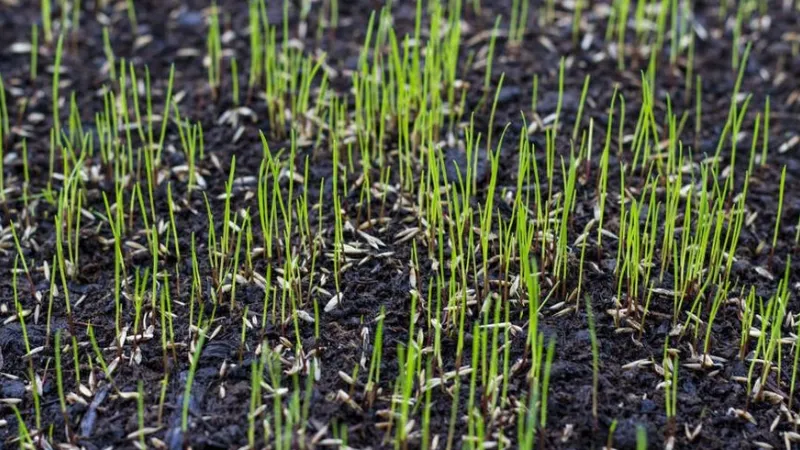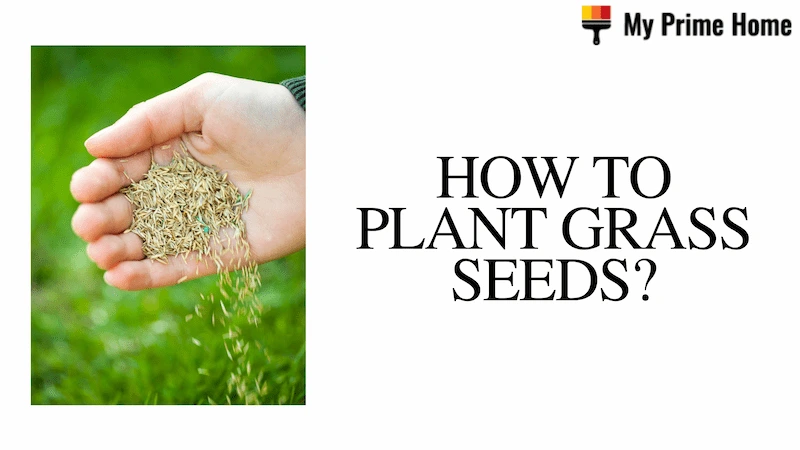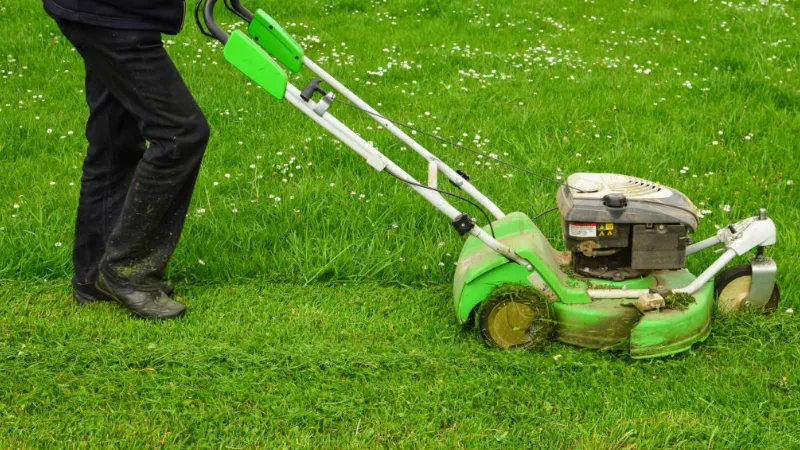Planting grass seed entails an investment of time, money, labor, and hope if you have your sights set on a thick, lush lawn. You can maximize your chances of success with seeding by being aware of your options and choosing the appropriate timing. So, when is the best time to plant grass seed? Below will also tell you how to plant grass seeds.
If you have cool-season grass, aim to start seeding in late summer or early fall before freezing air and soil temperatures hit your area. Start the seeding process in the late spring or early summer for warm-season grass.
Please read on for more detailed information.
Why Timing Matters?
When your planting season coincides with the seeds’ regular times of active growth, grass grows fastest and strongest. Lawn grasses have different growth cycles and regional climate preferences, just like other plant types in your landscape.
Cool-season grasses such as Kentucky bluegrass, perennial ryegrass and tall fescue, including Kentucky 31 tall fescue, grow most vigorously during the cool temperatures of late summer and early fall. These grasses flourish across cooler northern climates and into the challenging “transition zone” where cool and warm regions overlap.
Warm-season grasses, such as Bermudagrass, Bahiagrass, Zoysia grass and Centipede grass peak in growth during the warmer temperatures of late spring and early summer. These grasses flourish in the southwestern and southeastern parts of the transition zone.
Regardless of whether you grow cool-season or warm-season grasses, planting when your grass type naturally experiences its peak growth promotes rapid germination and establishment. Your seed is given the best possible start and is put on the path to both short-term and long-term success.
To develop your lawn maintenance strategy, learn how to identify crabgrass. Below will give you a full explanation of what is crabgrass.

Factors That Impact Seeding Times
While many homeowners have a lawn care schedule in the spring, it’s not enough to just complete seeding at any point during the season. You should take into account your location as well as the kind of grass you have, as these factors affect the ideal seeding conditions, in order to ensure proper growth.
Location
Your location has an impact on your climate, which in turn has an impact on the kind of grass you plant and the best time to seed it. For instance, warm-season grasses are used extensively in the south to manage the region’s year-round temperate climate. Other parts of the country, such as the midwest and far north, experience freezing temperatures that require cool-season grasses.
Warm-Season Grasses
Warm-season grasses naturally flourish in hotter climates. These grasses, which include St. Thomas grass, Bahia grass, Bermuda grass, zoysia grass, and centipede grass Augustine and other turfgrasses germinate in environments with air temperatures above 80 degrees Fahrenheit.
Warm-season grasses can typically be planted from early spring to late fall if you reside in a region of the country where temperatures remain relatively stable all year long. But make sure to plant your grass in late spring or early summer if your yard experiences the highs and lows of typical seasons.
Cool-Season Grasses
Cool-season grasses, including Kentucky bluegrass, tall fescue, fine fescue, and perennial ryegrass, fare better in areas of the country with temperate summers and chilly winters. This type of grass is dormant during the winter and grows during the fall and spring. It’s recommended that you plant your cool-season grass seed in late summer or early fall before temperatures dip below freezing. But, How Long Does Grass Seed Last?
Weather
It’s important to pay attention to other weather factors in addition to temperature, which influences whether you should plant cool-season or warm-season grass. For instance, a light drizzle may promote seed growth, whereas a heavy downpour may wash them away. In the days following seeding, check the radar to make sure no strong storms are headed your way.
In a similar vein, be sure to plant your seeds when the ground is sturdy and free of mud puddles, which can lead to disease. Additionally, you should stay away from windy conditions. Similar to how rain can wash seeds away, strong winds can blow newly-spread seeds across your existing lawn.
If nailing this timing seems too difficult, full-service lawn service providers like TruGreen lawn care can take care of seeding and fertilizing your lawn at the appropriate times.

What to Expect from Newly Planted Grass Seed?
All grass seedlings can root well and become established with the right timing before being subjected to external stresses. Depending on the type of grass you have, the climate where it grows, and the time of year, that can look different in your lawn.
The natural germination rates of different grass types and varieties vary. For instance, the germination time for cool-season Kentucky bluegrass can be two to three times longer than that of tall fescue varieties. Similarly, warm-season Zoysia grass may take two to three times longer than Bermudagrass. In addition, a variety of seed types with various rates of germination are often included in seed products.
Whether you’re repairing bare spots, overseeding an existing lawn or starting from scratch, you can generally expect grass seedlings to emerge within seven to 21 days when grown under proper conditions. It may take another three to four weeks of growth before grass is long enough to mow. This might entail delaying the first mowing for seed that was planted in the fall until the following spring. For some grasses, like Zoysia grass, it may take several months for them to reach their full potential.
New grass seedlings undergo a large portion of their initial growth below ground, where it is invisible to the naked eye. New roots help grass become firmly established, ready for the coming seasons, and placed for a strong, quick growth when their peak season comes. With proper timing, new grass seedlings compete well for light, water and nutrients and fight off lawn diseases and pests, including lawn weeds.
How to Maximize the Timing Advantage?
Your lawn still needs assistance to flourish, even if you plant your grass seed at the best time. Whether this is your first lawn or you’re the neighborhood expert, take some advice from turf professionals and get to know your grasses and your soil before you start seeding. Follow through on best practices for preparing and planting and don’t neglect traditional tasks, such as fall lawn care, that help keep your grass and soil healthy, well-nourished and ready to support new growth.
Do your research to understand what’s in a bag of grass seed and the company behind the seed. Pennington is committed to producing the finest grass seed products possible and providing you with educational resources to help your seed project succeed. By timing your lawn tasks properly, you can maximize your advantage and seed your way to the lawn of your dreams.
Can you mow wet grass? Short answer: No. Whether it’s early morning and the lawn is still dewy, a rainstorm just ended, or you just ran your sprinklers, you should skip the mow for now. Please read on for more detailed information.

How to Plant Grass Seed in Fall?
The ideal season for sowing grass seed is in the fall in many climates. In contrast to the cooling air temperatures, the still-warm soil of late August, September, October, or November promotes optimal root growth. This is ideal for growing lawn grasses and encouraging deep root development. Additionally, it improves the turf’s ability to access nutrients in the soil and drought resistance. Additionally, most regions experience more rain during the fall. You won’t need to haul out the hose and sprinkler as frequently as a result.
In the fall, when nighttime lows reach about 60 degrees F, it is time to sow grass seed. Watch the weather forecast. When a day or two of rain are anticipated, choose to sow grass seed.
Ways to Plant Grass Seed in Spring
Spring is another great time to seed the lawn. If you live somewhere where springs are long and cool, it’s especially beneficial. For spring planting, it is crucial to keep the seed and the sprouted grass regularly watered throughout the remainder of spring, summer, and well into the fall. It is common to link improper watering to establishment failures. Early summer is another possible time, but you’ll need to water more often.

Tips for Planting Grass Seed in the Winter
For either warm-season or cool-season grass seed, it is not advised to sow seeds in the winter. It has very little chance of surviving the winter and not washing away. Comparatively, the best times to start seeding projects are in the spring and fall.
Plant Grass Seed in the Summer
Cool Season Grass Seed
Since the grass will be dormant at this time, it is not advised to plant cool season grass seed. Unless you live in a very far-off northern region, it won’t be worth your time and effort. Before doing this, Sod University advises blocking out the months of June through early August.
Warm Season Grass Seed
In addition, the summer’s intense heat makes it unsuitable for warm-season grass seed. Irrigating it would require considerable time and expense. It is possible to do this in the summer, but you will have to invest a lot more time and money in the right kinds of irrigation.

FAQs
Is March Too Early to Plant Grass Seed?
For most grass seeds, March is too early to plant. Temperatures at this time of year will be too low unless you live in a warm area. Never plant grass before the daily average temperature is around 80 degrees Fahrenheit.
What Month is Best to Put Grass Seed Down?
The best month to put grass seed down depends on the type of grass you have. Early fall, or around September, is the ideal time to sow grass seed for cool-season grasses. For warm-season grasses, late spring or early summer is the optimal time.
Can You Plant Grass Seed in the Fall to Get It to Grow in the Spring?
You can plant grass seed in the fall to get it to grow in the spring through a process called dormant seeding. In this method of seeding, seeds are sown while the ground is still warm enough to support plant growth until spring but not yet frozen.
How Long Does It Take for Grass Seed to Germinate?
Turfgrass varieties vary in how long it takes for the seeds to sprout. Perennial rye grass, for instance, germinates in just 3 to 5 days, while fescues take closer to 10 days, Kentucky bluegrass, 2 to 3 weeks, and warm-season grasses like centipede, Bermuda, and zoysia grass, which can take up to a month.
If your grass seed is a mix of different types, be aware that not all of them will germinate simultaneously. It’s essential to keep the seeded area and the young plants well-watered until they are established in order to promote good germination and a healthy start regardless of the type of grass seed you planted.
Summary: Best Time to Plant Grass Seed
When seeding your lawn, timing is everything. In order to avoid freezing air and soil temperatures in your area, try to start seeding cool-season grass in the late summer or early fall. Warm-season grass seeding should start in the late spring or early summer.
No matter what kind of grass you choose to plant, make sure to maintain your lawn after the initial planting. If this process sounds too time-consuming, you might want to think about hiring a lawn care service to seed, fertilize, and maintain your yard all year long.
If you have any questions, please leave a comment. My Prime Home tries to give you the best home improvement information. Don’t forget to share the post. Thank you for reading.
Read about How to Get Rid of Crabgrass Naturally?



